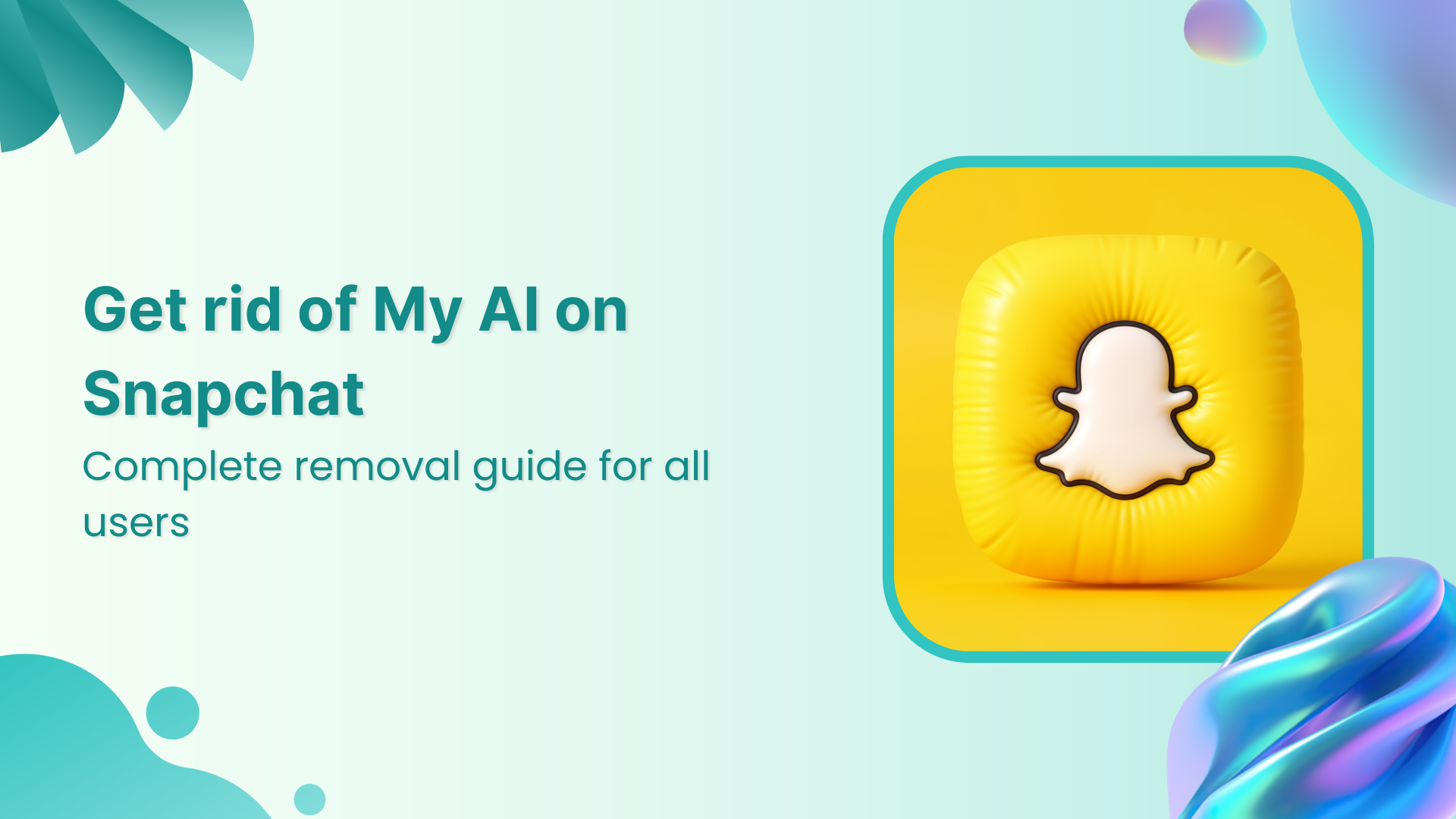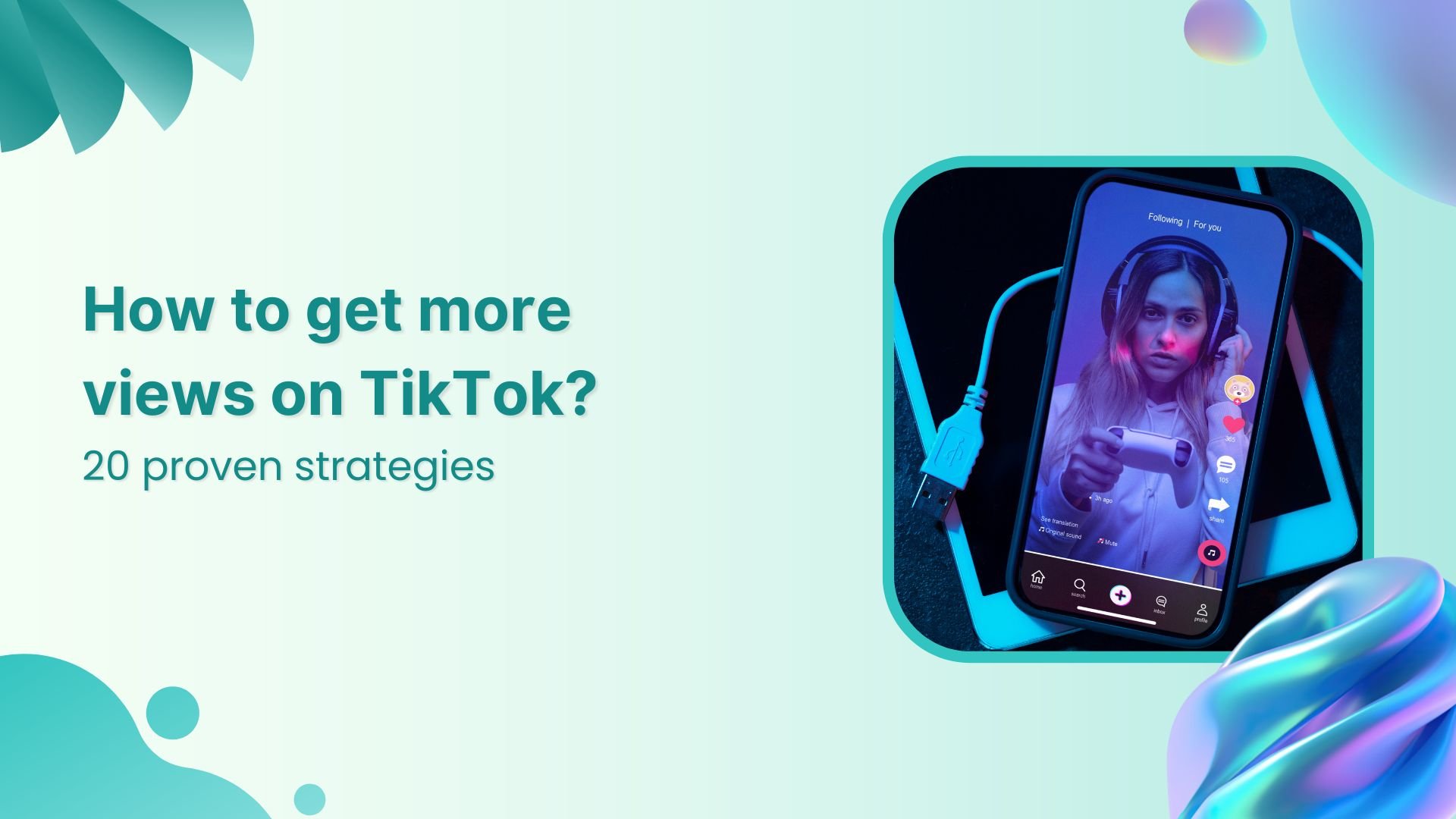Bulk-generate & schedule posts in seconds with Smart Scheduling. Try now!
Social Media Management [Complete 2025 Guide]

Social media has become an indispensable part of our daily lives and, by extension, a critical component of modern business strategy. As we navigate through 2025, understanding the nuances of social media management is more crucial than ever.
It’s not just about posting content online; it’s about building relationships, understanding social media analytics, and leveraging platforms for brand growth. This guide aims to shed light on what social media management entails, its evolution, and why it’s fundamental for businesses aiming to thrive in the digital age.
The easiest way to manage and grow your social channels.
Try ContentStudio for FREE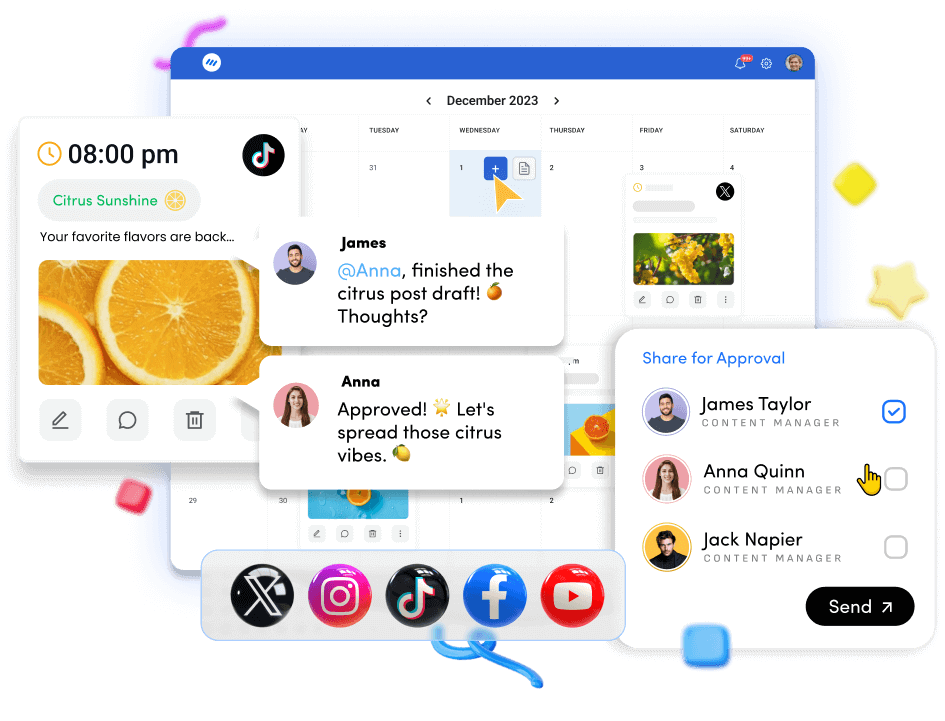
What is social media management?
Social media management is the strategic operation of all social media activities a business undertakes to engage with its audience across platforms. This involves planning, posting, analyzing, and engaging with content posted on social media platforms like Instagram, Facebook, Twitter, and LinkedIn. A social media manager’s role is multifaceted, encompassing content creation, market analysis, customer engagement, and performance monitoring.
For instance, a company launching a new product might use social media management to orchestrate a campaign that includes teaser posts, launch announcements, customer Q&As, and influencer partnerships, all coordinated to maximize social media reach and engagement. This approach not only amplifies the product’s visibility but also fosters a sense of community and feedback around it.
How has social media management evolved over the years?
The early days of digital marketing
The landscape of social media management underwent significant transformation since the early days of digital marketing. Initially, businesses viewed social media platforms like MySpace and the early versions of Facebook merely as bulletin boards to announce their products or services. There was little emphasis on engagement or analytics.
The content was broad and not tailored to specific audience segments. These platforms primarily served as a digital space for users to connect rather than a sophisticated marketing tool.

The rise of algorithms and engagement
As social platforms introduced more sophisticated algorithms, businesses began to understand the importance of targeted content and engagement. Twitter, for example, introduced hashtag usage which allowed posts to become part of larger conversations, increasing organic reach.

The era of organic reach peaked, where cleverly crafted content on platforms like Facebook could go viral, garnering millions of views without financial investment. However, as platforms like Instagram evolved their algorithms to prioritize user experience over corporate visibility, the focus shifted towards paid advertising and content marketing strategies tailored to engage and retain audience attention.
Introduction of sophisticated analytics
The introduction of sophisticated analytics tools transformed social media management into a data-driven field. Platforms such as LinkedIn and Facebook developed robust analytics dashboards, enabling managers to analyze the performance of their posts, understand audience behaviors, and tailor their strategies accordingly. This shift enabled brands to optimize their social media campaigns for better engagement and return on investment (ROI), making decisions based on solid data rather than intuition.
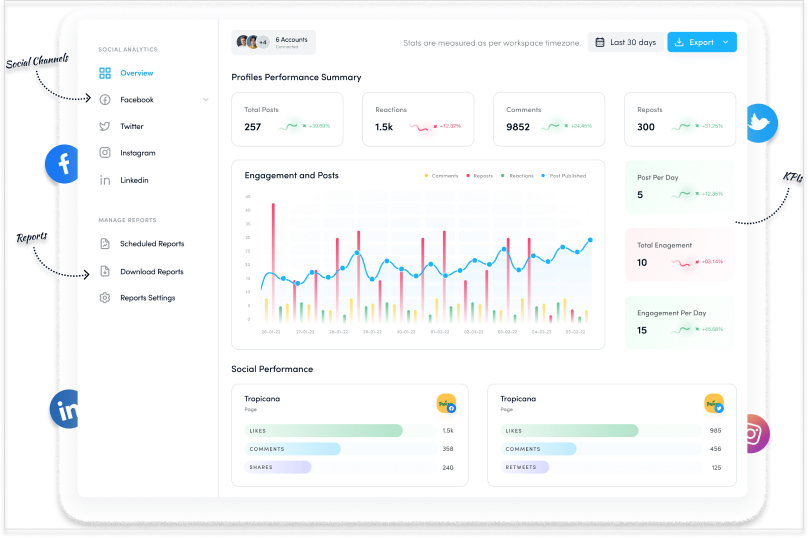
The dominance of visual and video content
Visual content became king, with platforms like Instagram and Pinterest leading the way in image-driven communication. Instagram’s introduction of Stories and Facebook’s launch of Live videos revolutionized the way brands engaged with their audiences, offering new avenues for real-time interaction and adding a human touch to digital interactions.

Additionally, the advent of TikTok introduced a platform dedicated to short, engaging video content, further emphasizing the importance of creating entertaining and informative content. YouTube’s evolution into a platform for both entertainment and informative content, with features like YouTube Live, further diversified the content landscape, making visual and video content a cornerstone of modern social media strategy.
Shift towards authenticity and social responsibility
In recent years, the focus has also shifted towards authenticity and social responsibility. Brands are now expected to not only promote their products but also stand for values and engage in social issues, building deeper connections with their audiences. Social media management now involves navigating these expectations, leveraging user-generated content, and fostering community through more personal and meaningful interactions.

The journey of social media management reflects the broader evolution of the internet and digital communication. From basic posts to sophisticated, interactive, and data-driven campaigns, the field has grown to become an essential element of digital marketing strategies, requiring a blend of creativity, analytical skills, and strategic thinking.
Why is an effective social media management process important?
- Enhances brand visibility
An effective social media management process ensures that your brand consistently engages with its audience, keeping you at the forefront of their minds. Regularly updated content across platforms like Instagram and Facebook increases your brand’s visibility, drawing in new followers and potential customers. Through strategic posting and engagement, you become a familiar and trusted name in your industry.
- Builds community and loyalty
By engaging directly with your audience, responding to comments, and sharing relevant content, you foster a sense of community. Platforms like Twitter allow for real-time interactions, where your prompt responses to customer queries or concerns can significantly boost brand loyalty and encourage a more engaged following.
- Supports crisis management
In times of a brand crisis, effective social media management becomes crucial. Quick and transparent communication on platforms like Facebook can help mitigate issues before they escalate. By monitoring social conversations, you can address concerns promptly and maintain your brand’s reputation.
- Drives website traffic and sales
Strategic social media management can significantly increase traffic to your website. Sharing engaging content on Pinterest that links back to your site, for example, can attract visitors interested in your products or services, ultimately boosting sales and conversions.
- Facilitates targeted advertising
Platforms like Instagram offer sophisticated advertising options that allow you to reach your desired audience with precision. Effective management of these tools ensures that your advertising budget is used efficiently, reaching potential customers who are most likely to be interested in what you offer.
Each of these reasons highlights the indispensable role of social media management in today’s digital marketing landscape, underscoring the need for businesses to invest in a robust, strategic approach to their online presence.
8 Key components of social media management
1. Strategy development
An effective social media management plan is anchored in a well-thought-out strategy. This foundational step involves setting clear objectives, such as increasing brand awareness or driving website traffic, and deeply understanding who your audience is, including their preferences and online behaviors.
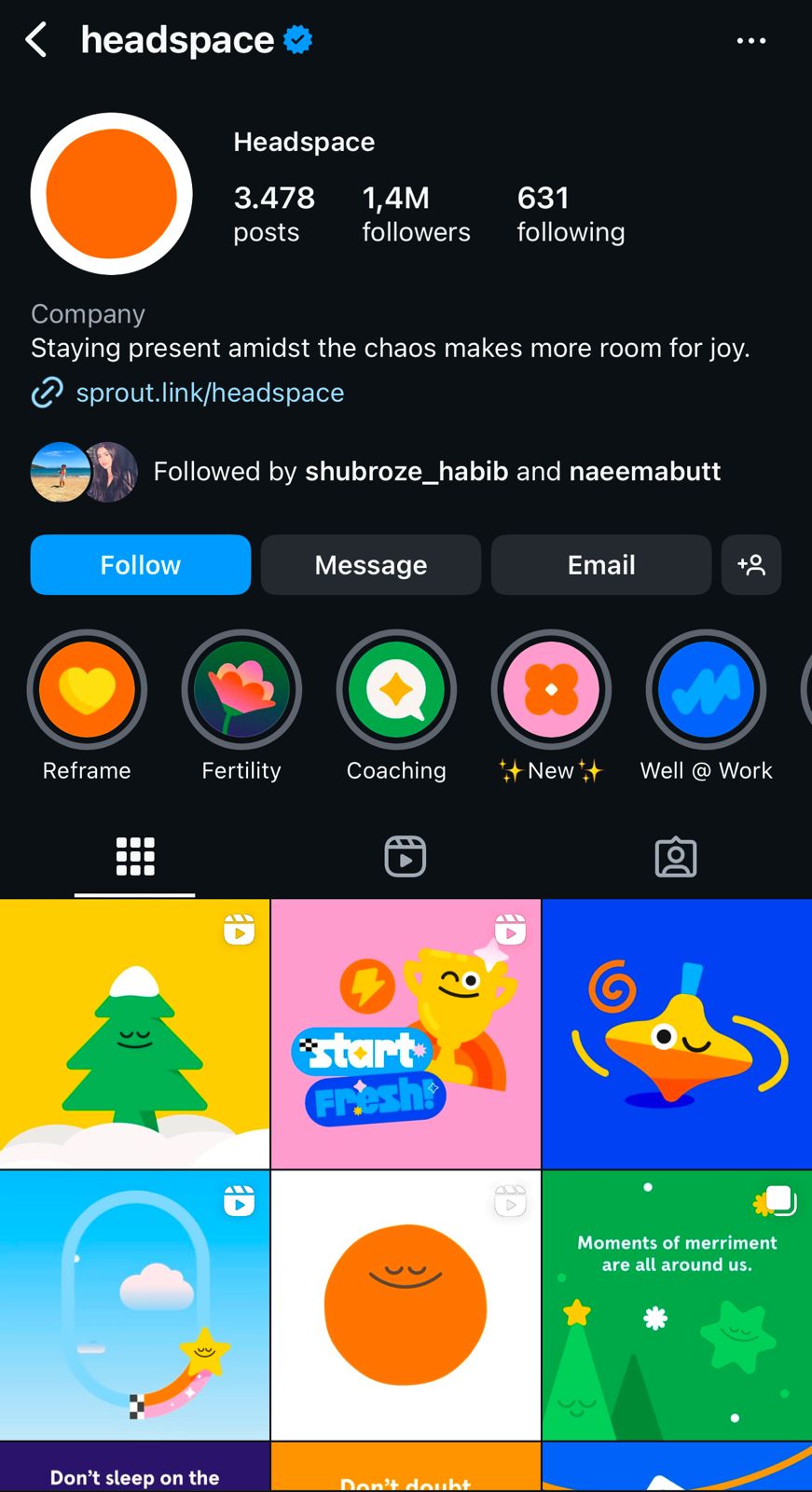
For instance, Headspace is a leading mental health and wellness platform dedicated to improving the health and happiness of the world. Through strategic use of social media, particularly TikTok and Instagram, Headspace educates its audience on psychological disorders by sharing personal stories of those who have benefited from their services. This method not only highlights the importance of mental health but also showcases the effectiveness of their mindfulness tools, fostering a supportive community that aligns with their mission to make mental health support accessible to all.
2. Content creation
Content is the heart of social media management. This includes everything from writing posts and creating graphics to producing videos and stories. A prime example is Glossier’s approach to content creation, characterized by curating and showcasing customer experiences on platforms like Instagram, has significantly enhanced its brand identity, fostering a deeply engaged and loyal community.

The brand’s social media content strategy focuses on leveraging user-generated content (UGC) to reflect the real-world application of its products. By encouraging customers to share their experiences using hashtags like #GlossierRep and #GlossierPink, Glossier has cultivated a rich repository of authentic content. This strategy not only showcases their products in use but also amplifies customer voices, reinforcing the brand’s commitment to individuality and self-expression.
3. Scheduling and publishing
Maintaining a consistent presence on social media is essential, and scheduling tools play a crucial role in achieving this. These tools enable managers to efficiently plan and automate content release across various platforms, ensuring maximum engagement.

A prime example of this strategy in action is Adobe Creative Cloud’s use of YouTube for their live Friday masterclasses. Adobe has harnessed the power of scheduling to regularly share comprehensive, hour-long sessions that offer valuable tips and tricks, all beginning with their signature branded intro. This approach not only ensures consistent engagement with their creative community but also solidifies Adobe’s position as a thought leader in the creative software space, demonstrating the effectiveness of well-timed, educational content.
Social Media Content Calendar
Stay consistent and organized with Contentstudio’s social media content calendar for marketers and agencies.
Get Started for FREE
4. Engagement
Engagement transcends mere content posting; it’s about actively connecting with your audience to cultivate a vibrant community. It’s the art of transforming passive viewers into active participants.

KLM Royal Dutch Airlines stands out as a beacon of effective engagement by meeting customers where they are. Particularly noteworthy is their “What the FAQ” series on Instagram Stories, where they tackle technical air travel queries. This initiative not only underscores KLM’s commitment to customer service but also drives significant interactions.
Social Customer Service
Never miss a message or comment from your social media audience. Try ContentStudio’s Inbox.
Get Started for FREE
5. Analytics and reporting
Understanding the impact of your social media efforts is crucial. Analytics tools provided by social media platforms or third-party applications offer insights into post performance, audience demographics, and engagement rates. Nike’s approach to social media, especially on Instagram, underscores the pivotal role of analytics and reporting in tailoring content to audience preferences. Despite posting less frequently, with an average of around 12 posts per month, Nike’s strategic use of analytics tools has enabled the brand to achieve remarkable engagement.
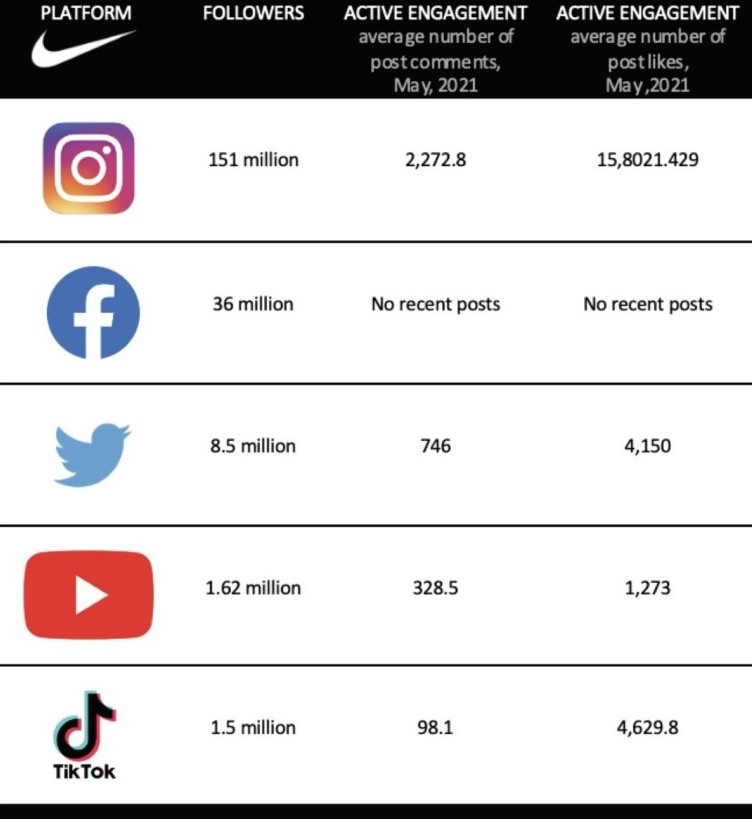
By analyzing engagement patterns, Nike identifies what content mix works best, from celebrating milestones like reaching one million followers with gratitude posts to creating topical content around events like the FIFA World Cup. This data-driven strategy allows Nike to maintain a leading position on Instagram by prioritizing quality and relevance over quantity, proving that a well-informed approach to content can significantly amplify engagement and build a dedicated community.
Social Media Analytics
Fine-tune your social media strategy for success with in-depth analytics and white-labeled reports.
Get Started for FREE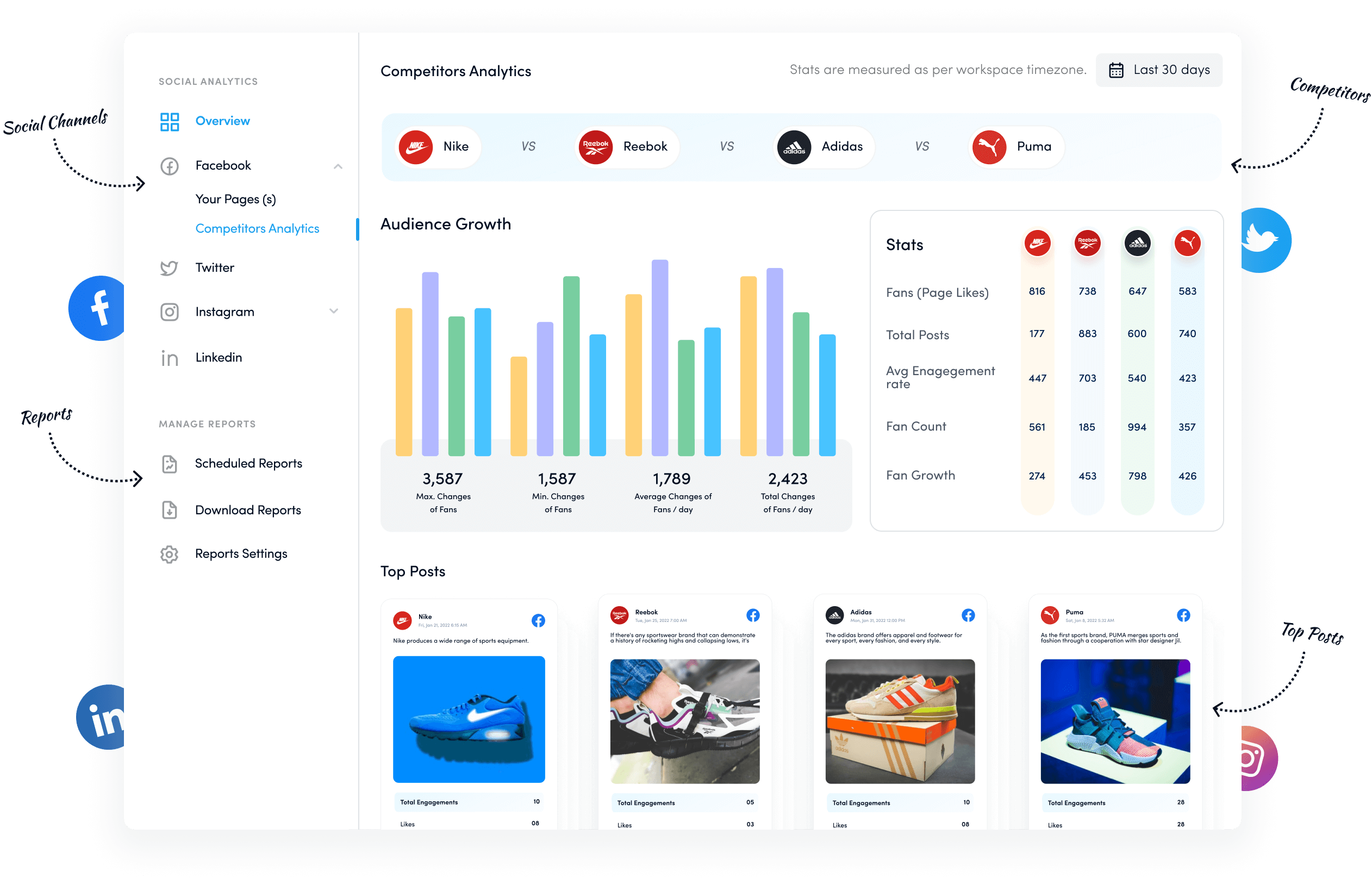
6. Advertising
Social media advertising is a crucial strategy for brands looking to expand their audience reach beyond their current followers. Platforms such as Facebook and Instagram enable precise targeting based on user interests, behaviors, and demographics. Additionally, YouTube advertising emerges as a potent medium, allowing brands to place ads before or during videos, tapping into the platform’s vast and diverse viewer base.

A notable example is the collaboration between Friskies and BuzzFeed for the “Dear Kitten” video series. This creative partnership resulted in a viral YouTube ad campaign where an older cat imparts wisdom to a new kitten, combining humor with brand messaging. The original video amassed over 32 million views, demonstrating the power of YouTube advertising to generate significant engagement and brand awareness. By leveraging the storytelling potential of YouTube ads, Friskies not only captivated millions of viewers but also set a benchmark for successful video advertising campaigns.
7. Listening and monitoring
Social listening and monitoring are critical for understanding the public perception of your brand, staying ahead of competitors, and identifying emerging trends. By meticulously tracking mentions and conversations across social platforms, brands can glean valuable insights into customer sentiment and feedback.
Airbnb’s adept use of social listening is a prime example of how timely and appropriate action can significantly boost a brand’s image. When a video by a TikTok user, Earle, detailing how her group got stranded and the video garnered over 3.9 million views, Airbnb’s social media team quickly took notice. Within 24 hours, Airbnb had arranged for the group to stay in a nearby villa, turning a potential travel disaster into a positive experience. Earle’s follow-up TikTok video, showcasing the villa provided by Airbnb, received over 3.8 million views, painting Airbnb in a remarkably positive light. This proactive approach not only earned Airbnb nearly 4 million impressions but also highlighted the importance of being responsive and ready to act on real-time information.
8. Crisis management
Crisis management within social media management is crucial for safeguarding a brand’s reputation during unforeseen events or when facing public scrutiny. This involves having a comprehensive plan that outlines steps for quick and effective responses to negative feedback or PR crises, ensuring communication is clear, empathetic, and aligned with the brand’s values.

Effective crisis management is pivotal for maintaining a brand’s integrity and customer loyalty. Starbucks exemplifies this with its nuanced approach to addressing customer complaints. Rather than offering a generic apology, Starbucks adopts an investigative stance, asking for specific details like the store location and visit time when a customer reports a negative experience. This not only demonstrates a genuine commitment to resolving the issue but also personalizes the interaction, making customers feel heard and valued.
How to Develop a Social Media Management Strategy?
1. Define your objectives
Start by establishing clear, measurable goals for what you want to achieve through your social media channels. Whether it’s increasing brand awareness, driving website traffic, or boosting sales, your objectives should guide your strategy.
For example, a small online bookstore aiming to increase sales might set a specific goal to boost online orders by 20% within six months through targeted Facebook ads and Instagram stories highlighting bestsellers and customer reviews.

2. Understand your audience
Knowing your target audience is crucial for effective social media management. This involves identifying their interests, behaviors, and the platforms they frequent.
For instance, a fitness apparel brand targeting young adults might focus on Instagram and TikTok, using influencers to showcase their products in action. They could use analytics tools to track engagement rates and tailor their content strategy to what resonates most with their audience.

3. Choose the right platforms
Not all social media platforms will be right for your brand. Select platforms based on where your target audience spends their time and the nature of your content.
A B2B company, for example, might prioritize LinkedIn for sharing industry insights and networking, while a beauty brand might focus on Instagram and Pinterest to showcase visually appealing product images.
4. Content planning and creation
Develop a content calendar that outlines what, when, and where you’ll post. Content should align with your brand voice and objectives, offering value to your audience. For example, a home gardening brand might use Instagram to share daily gardening tips, behind-the-scenes looks at product development, and user-generated content of customers’ gardens. Planning ensures a consistent and engaging presence across channels.

5. Engagement strategy
Plan how you will interact with your audience to build relationships and encourage loyalty. This could involve responding to comments, hosting live Q&A sessions, or running interactive polls. For instance, a coffee shop chain could use Twitter to engage customers by asking for their favorite seasonal drink flavors, then share polls to let them vote on new menu additions.

6. Implement analytics and reporting
Use analytics tools to track the performance of your social media activities against your objectives. This data will help you understand what’s working and what needs adjustment. A digital marketing agency might analyze the engagement and conversion rates of their articles to refine their Linkedin content strategy for driving leads.

7. Advertising and promotion
Incorporate paid social media strategies to amplify your reach and achieve specific objectives. For instance, an e-commerce fashion retailer could use Facebook’s targeted advertising to reach potential customers based on their browsing behavior and interests, showcasing seasonal promotions or new arrivals.

8. Crisis management and response
Prepare a plan for managing potential social media crises, including negative feedback or PR issues. This involves monitoring mentions of your brand and having protocols for timely and appropriate responses. An example is an airline that monitors social media for mentions of flight delays or cancellations, quickly addressing customer concerns and providing updates to mitigate frustration and maintain trust.

Top 8 social media management tools
Social media management tools are indispensable for businesses looking to streamline their online presence, engage with their audience more effectively, and analyze the impact of their digital strategies. These tools not only save time but also provide critical insights into content performance and audience behavior, enabling businesses to refine their strategies for optimal engagement and reach. Here, we discuss four leading tools that stand out in the realm of social media management for businesses.
1. ContentStudio
ContentStudio offers an AI-driven platform that simplifies content discovery, planning, creation, and sharing across social media and blogging channels. Its comprehensive suite is particularly beneficial for small to midsize businesses and solo entrepreneurs seeking to manage their social media presence efficiently from a single dashboard. The tool’s ability to generate AI captions and hashtags enhances post engagement, while its visual calendar and smarter scheduling features help businesses maintain a consistent online presence.

Moreover, ContentStudio’s multi-channel analytics allow businesses to fine-tune their strategies based on data-driven insights. The integration with Canva and VistaCreate enables the creation of visually appealing posts, crucial for capturing audience attention. Despite its steep learning curve, ContentStudio remains a favorite for businesses aiming to elevate their content marketing and social media management without spreading resources too thin across multiple platforms.
2. Hootsuite
Hootsuite stands as a veteran in the social media management space, offering a unified dashboard for scheduling posts, analyzing performance, and engaging with audiences across various platforms. This tool is particularly adept at managing multiple accounts, making it a go-to for businesses with a presence on several social media channels. Hootsuite’s unified social inbox is a standout feature, allowing businesses to efficiently manage interactions and brand mentions in one place, ensuring no customer inquiry or feedback goes unnoticed.

While Hootsuite’s advanced analytics and social listening features may come at a premium, they provide invaluable insights into campaign performance and audience sentiment. The tool’s integration with Canva enhances content creation, ensuring posts are both engaging and on-brand. Despite some user experience challenges, Hootsuite’s comprehensive features make it an essential tool for businesses looking to optimize their social media strategies and foster deeper connections with their audience.
3. Zoho Social
Zoho Social shines with its intuitive interface and intelligent predictions on the best times to post, making it a favorite among businesses for its ease of use and actionable insights. The platform’s SmartQ feature is particularly useful for maximizing engagement by scheduling posts when the audience is most active. Additionally, Zoho Social’s integration with Zoho’s CRM system allows businesses to manage leads generated from social media more effectively, providing a seamless transition from engagement to conversion.

The tool also excels in collaboration and approval processes, ensuring that all content aligns with brand standards before publication. Although it lacks some advanced content creation tools, Zoho Social’s strengths in scheduling, analytics, and CRM integration make it a powerful ally for businesses aiming to enhance their social media presence while fostering meaningful connections with their audience.
4. Buffer
Buffer offers a streamlined approach to social media management, with a focus on scheduling, analytics, and team collaboration. Its clean, intuitive interface makes planning and publishing content across multiple channels a breeze, while advanced analytics provide insights into post performance and audience engagement. Buffer’s Pablo, a built-in photo editing tool, enables businesses to create visually compelling content without needing external software.

The platform’s emphasis on Instagram, including features tailored to the platform like first comment and shop grid, makes it particularly valuable for businesses looking to leverage Instagram’s vast marketing potential. However, Buffer’s model requires supplementary tools for comprehensive engagement and listening capabilities, which may increase overall costs. Despite this, Buffer’s efficiency and user-friendly design make it an excellent choice for small to medium-sized businesses focused on building a cohesive and engaging social media presence.
5. Sprout Social
Sprout Social is renowned for its depth in analytics and ability to foster community engagement, making it an indispensable tool for businesses serious about understanding and expanding their social media footprint. Its collaborative content calendar and advanced post scheduler streamline content planning and distribution across multiple profiles and networks. One of Sprout Social’s most appreciated features is its unified social inbox, which simplifies the process of monitoring and engaging with audience interactions across platforms, ensuring that no message is overlooked.

Businesses benefit from Sprout Social’s detailed reporting and competitor analysis, gaining insights not just on their performance but also on where they stand in the industry landscape. While its pricing may be on the higher end, the value it provides in terms of comprehensive monitoring, engagement, and analytics tools justifies the investment for businesses aiming to make a significant impact through their social media strategies.
6. Later
Later is particularly favored by businesses for its visual content planning and Instagram-focused features, making it a staple for those prioritizing this platform. Its drag-and-drop calendar and the ability to visually plan and schedule posts help businesses maintain an aesthetically cohesive Instagram feed. Later’s “Linkin.bio” feature addresses the one-link limitation on Instagram, directing followers to a customized landing page with multiple links, thereby enhancing the potential for website traffic and conversions.

Despite its strong Instagram orientation, Later supports scheduling for other major platforms, offering analytics to track performance. While some features are limited to Instagram, Later’s user-friendly interface and effective planning tools make it an excellent choice for businesses looking to streamline their visual content strategy and boost engagement on Instagram and beyond.
7. Agorapulse
Agorapulse stands out for its user-friendly interface and comprehensive feature set, encompassing scheduling, posting, monitoring, and reporting. Its unique audience analysis tool, which uses labels to categorize and track engagement from followers, provides businesses with a clear understanding of who their most loyal and active audience members are. This insight allows for targeted content creation and personalized engagement strategies.

The platform’s strength lies in its unified inbox, where businesses can manage all social media interactions, making community management more manageable and more effective. While Agorapulse may not support as wide a range of platforms as some of its competitors, its robust analytics, and engagement tools, combined with a straightforward pricing model, make it a competitive option for businesses looking to deepen audience relationships and streamline their social media management.
8. CoSchedule
CoSchedule serves businesses as an all-in-one marketing calendar, bringing clarity and efficiency to managing social media alongside other marketing activities. Its ability to consolidate content planning, scheduling, and team collaboration in one visual platform helps businesses stay organized and maintain a consistent posting schedule. CoSchedule’s ReQueue feature is particularly useful for automatically filling content gaps in the schedule, ensuring that social media feeds remain active and engaged.

While CoSchedule excels at planning and scheduling, it also offers analytics to measure social media performance, though some businesses may seek additional depth in this area. Its integration with blogging platforms and email marketing services makes CoSchedule an attractive choice for businesses looking for a comprehensive tool to manage all aspects of their content marketing strategy from a single dashboard.
Wrapping up
In 2025, effective social media management is crucial for businesses to thrive in the digital realm. This guide has explored essential strategies, the importance of engaging content, analytics, crisis management, and highlighted key tools like ContentStudio, Hootsuite, Zoho Social, Buffer, Sprout Social, Later, Agorapulse, and CoSchedule. These tools provide unique features for content creation, scheduling, audience engagement, and analytics, tailored to meet diverse business needs.
The right social media management strategy, informed by an understanding of business goals and audience preferences, enables businesses to build a strong online presence. Combining creativity, strategic planning, and technology, businesses can effectively engage their target audience, driving growth and success in the digital landscape.
Frequently asked questions
What is social media management?
Social media management involves overseeing a brand’s presence across social platforms. It includes content creation, posting schedules, engagement with followers, analytics review, and strategy optimization to achieve marketing goals and foster community.
How much to charge for social media management?
Charging for social media management varies widely; it can range from $400 to $7,000+ per month based on the scope, platforms managed, content creation, and strategy complexity. Tailor your pricing to the services provided and the client’s budget.
How to get into social media management?
To get into social media management, start by mastering social media platforms, analytics tools, and content creation strategies. Build a portfolio by managing accounts voluntarily or as internships. Stay updated with digital marketing trends and consider formal training or certifications to enhance your skills and credibility.
Recommended for you

Reputation management strategy in 2026: What every business needs to know


Powerful social media management software
14-day free trial - No credit card required.
